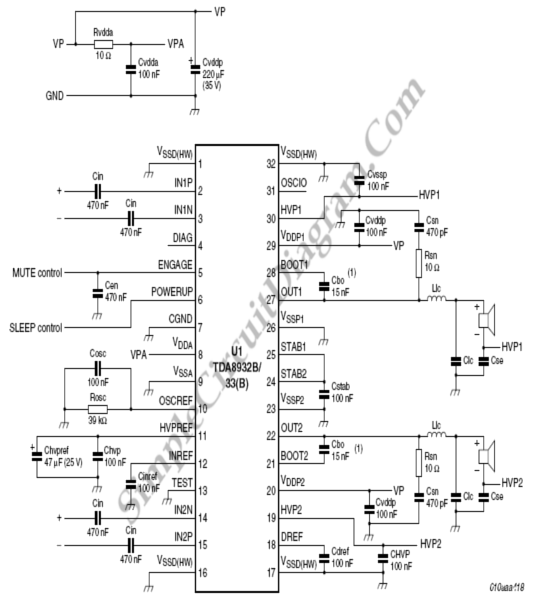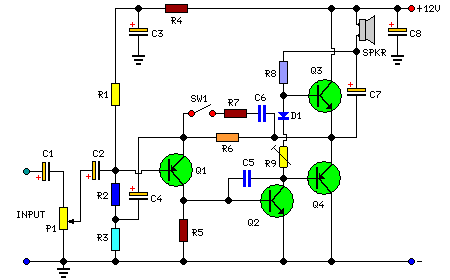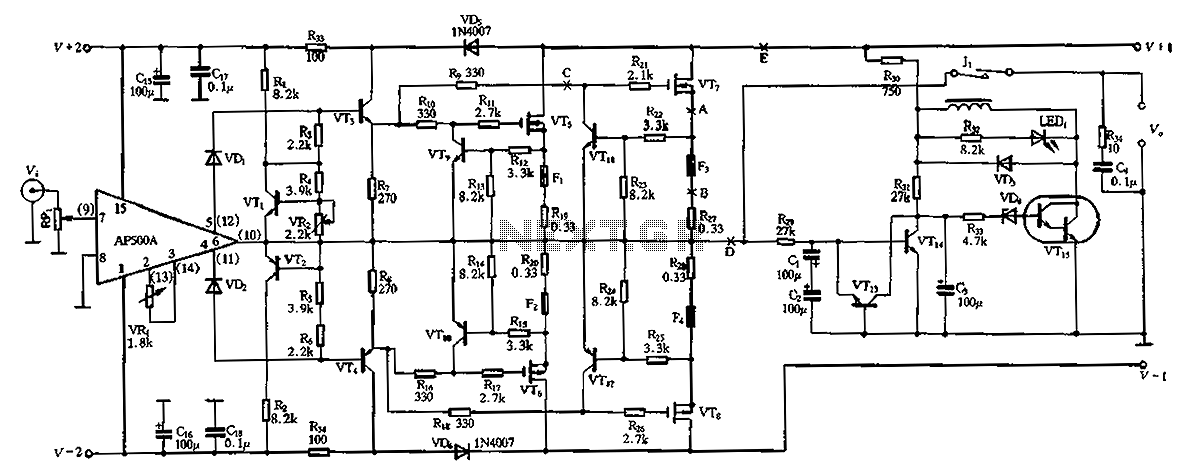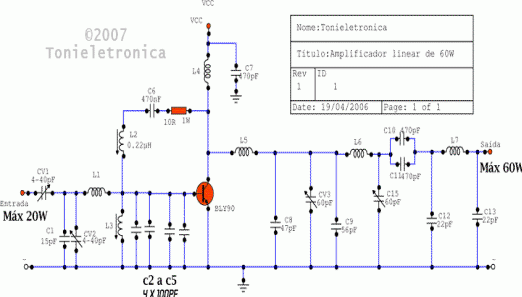
Dedicated headphone amplifier integrated amplifier LM4880-02

Enthusiasts understand that connecting headphones directly into the universal headphone jack to listen to VCD results in subpar sound quality. The audio performance when using a tape player is similarly affected. An amplifier is necessary, and the RC4558, which is a dual operational amplifier, is commonly used for this purpose. However, its output impedance is high, and it exhibits poor performance under heavy loads. This leads to a harsh treble response and a lack of brightness, while the bass frequency response is noticeably inadequate. Therefore, a dedicated headphone output is essential. Figure 5-41 illustrates one example of such a circuit.
The circuit in Figure 5-41 represents a headphone amplifier utilizing the RC4558 dual operational amplifier. This integrated circuit is designed to enhance audio signals, providing improved sound quality for headphone use. The RC4558 features two independent, high-gain, internally frequency-compensated operational amplifiers, making it suitable for audio applications.
In this schematic, the input stage typically consists of a coupling capacitor that blocks any DC component from the audio source, allowing only the AC audio signal to pass through. This is crucial for preventing any potential damage to the headphones and ensuring a clean audio signal. The gain configuration is set by resistors connected to the feedback loop of the operational amplifier, allowing for customization of the amplification factor based on the desired output level.
The output stage is designed to match the impedance of typical headphones, which are usually around 32 ohms. To achieve this, the circuit may include a resistor in series with the output to help control the output impedance, thereby improving the load characteristics. Additionally, capacitors may be employed to filter out high-frequency noise, ensuring a clearer sound.
It is essential to consider power supply decoupling in this design. Bypass capacitors are typically placed close to the power supply pins of the RC4558 to stabilize the voltage and reduce noise, which can adversely affect audio quality.
Overall, this headphone amplifier circuit provides a significant improvement over directly connecting to a headphone jack, addressing the common issues of high output impedance and inadequate frequency response. By implementing this design, enthusiasts can enjoy a more satisfying listening experience with enhanced clarity and balanced audio performance.Enthusiasts know that the headphones directly into the universal headphone jack to listen to VCD, the sound quality is not high and the tape player to listen to reason D headph one amplifier is here almost all of RC4558 like amplified voltage integrated dual operational amplifier, the output impedance is high, heavy load characteristics are poor, Xin feeling harsh treble performance, the lack of a sense of bright, bass frequency response range and obviously inadequate. As required headphone output must fight Mount. Figure 5-41 circuit is one example.
The circuit in Figure 5-41 represents a headphone amplifier utilizing the RC4558 dual operational amplifier. This integrated circuit is designed to enhance audio signals, providing improved sound quality for headphone use. The RC4558 features two independent, high-gain, internally frequency-compensated operational amplifiers, making it suitable for audio applications.
In this schematic, the input stage typically consists of a coupling capacitor that blocks any DC component from the audio source, allowing only the AC audio signal to pass through. This is crucial for preventing any potential damage to the headphones and ensuring a clean audio signal. The gain configuration is set by resistors connected to the feedback loop of the operational amplifier, allowing for customization of the amplification factor based on the desired output level.
The output stage is designed to match the impedance of typical headphones, which are usually around 32 ohms. To achieve this, the circuit may include a resistor in series with the output to help control the output impedance, thereby improving the load characteristics. Additionally, capacitors may be employed to filter out high-frequency noise, ensuring a clearer sound.
It is essential to consider power supply decoupling in this design. Bypass capacitors are typically placed close to the power supply pins of the RC4558 to stabilize the voltage and reduce noise, which can adversely affect audio quality.
Overall, this headphone amplifier circuit provides a significant improvement over directly connecting to a headphone jack, addressing the common issues of high output impedance and inadequate frequency response. By implementing this design, enthusiasts can enjoy a more satisfying listening experience with enhanced clarity and balanced audio performance.Enthusiasts know that the headphones directly into the universal headphone jack to listen to VCD, the sound quality is not high and the tape player to listen to reason D headph one amplifier is here almost all of RC4558 like amplified voltage integrated dual operational amplifier, the output impedance is high, heavy load characteristics are poor, Xin feeling harsh treble performance, the lack of a sense of bright, bass frequency response range and obviously inadequate. As required headphone output must fight Mount. Figure 5-41 circuit is one example.





